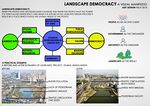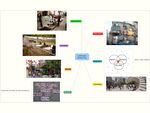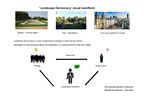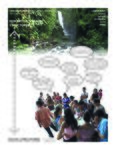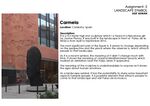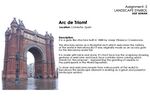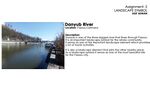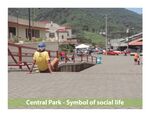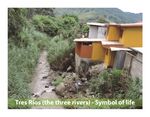LED Online Seminar 2018 - Working Group 3
--> Back to working group overview
Dear working group members. This is your group page and you will be completing the template gradually as we move through the seminar. Good luck and enjoy your collaboration!
Assignment 1 - Reading and Synthesizing Core Terminology
- You can read more details about this assignment here
- Readings are accessible via the resources page
Step 1: Your Landscape Democracy Manifestoes
Step 2: Define your readings
- Please add your readings selection for the terminology exercise before April 18:
A: Landscape and Democracy
B: Concepts of Participation
C: Community and Identity
D: Designing
E: Communicating a Vision
Steps 3 and 4: Concepts Selection and definition
- Each group member selects three relevant concepts derived from his/her readings and synthesize them/publish them on the wiki by May 9, 2018
- Group members reflect within their groups and define their chosen concepts into a shared definition to be posted on the wiki by June 6, 2018.
- Other group members will be able to comment on the definitions until June 12, 2018
- Each group will also report on their process to come to a set of shared definitions of key landscape democracy concepts on the wiki documentation until June 20, 2018
Concepts and definitions
Author 1: ...
- ......
- .......
- .......
Author 2: ...
- ......
- .......
- .......
Author 3: ...
- ......
- .......
- .......
Author 4: ...
- ......
- .......
- .......
Step 5: Reflection
Step 6: Revised manifestoes
- please look again at your initial manifestoes and update them with any new aspects/prespectives you have taken up during this seminar
Assignment 2 - Your Landscape Symbols
- You can read more details about this assignment here
Landscape Symbols Author 1: ...
Landscape Symbols Author 2: ...
- Symbol yourname photovoice1
add a caption (one paragraph max) description of the symbolism, interpretation, as well as geo-location
- Symbol yourname photovoice2
add a caption (one paragraph max) description of the symbolism, interpretation, as well as geo-location
- Symbol yourname photovoice3
add a caption (one paragraph max) description of the symbolism, interpretation, as well as geo-location
Landscape Symbols Auther 3: ...
- Symbol yourname photovoice1
add a caption (one paragraph max) description of the symbolism, interpretation, as well as geo-location
- Symbol yourname photovoice2
add a caption (one paragraph max) description of the symbolism, interpretation, as well as geo-location
- Symbol yourname photovoice3
add a caption (one paragraph max) description of the symbolism, interpretation, as well as geo-location
Landscape Symbols Author 4: ...
- The village has a calm, relaxed atmosphere and outstanding views of Mediterranean Sea
- Everything is well-kept with white washed walls, blue doors and windows with traditional motifs.
- Behind these doors, famous artists such as Paul Klee and Louis Moillet, musicians, important families and government officials have lived and worked.
- Well, these doors represent the sense of charm, beauty, history and culture that Sidi Bou Said holds.
- It was occupied and looted by the German military during World War II.
- Now, it is a fascinating museum for Arabic and Mediterranean music.
- This palace is symbol of Tunisian musical heritage where musicians, and choral groups from around the world perform on a regular basis.
- It is a labyrinthine ancient city surrounded by a continuous wall.
- Souks are enormous; covered or uncovered they offer an infinity of colors, flavors and scents.
Landscape Symbols Author 5: Luis Solano
This case study is a good example of NO democratic landscape. Why?Central Park has historically been a meeting place, meeting, leisure, social gathering, mass events, fairs, a lot of social activity and a striking and characteristic vegetation that gave comfort to the space. However, for 2009 its remodeling is announced in a design process that did not have an open to consultation and public participation. The new space has a much more open and permeable concept, freeing large areas for activities on platforms, and although it allows an incredible view of the mountains of La Carpintera, it reduces the activities of small areas liked by users. Although the space has had a good flexibility and functionality for the different activities that occur in it, the fact of not having the support of the community during its conception broke all the sentimental links and attachments with the space, generating a disagreement with a considerable part of the community. Fortunately, the constant use of space has not been lost thanks to the numerous activities that surround it, even today the symbolism as a social space of encounter is maintained.
My town gets its name literally by a very particular water condition, it is crossed by three important rivers, from here its name Tres Ríos (in English, literally Three Rivers). They are the Chiquito, Cruz and Tiribí rivers. The latter continues through the rest of the city through the southern sector. These water systems have an incalculable value, because in their springs drinking water purification systems are used for consumption in my town and sectors of other large cities such as Desamparados, Curridabat and San Pedro. Unfortunately this is a forgotten landscape, often remembered only during the heavy rainy periods, when nature reminds us of its power. Many rivers increase their channels considerably or leave them causing damage and emergencies. This is a good topic of reflection, to think about how our city is planned, what participation and role the community living in its surroundings takes and the possibility of studying successful cases in Latin America that have incorporated water bodies into urban dynamics.
These mountains with the rivers have an enormous importance in our town at a historical, identity and natural level. Almost every inhabitant of the town has climbed once in his life to the top. Its value as a symbol has lasted over time through many generations, but it has also suffered the pressure of urban growth and deforestation zones. They are part of a larger biological correodor that connects several mountain ranges to the east and west. It was declared a Protected Area in 1976, helping to preserve its fragile ecosystems in an area of 2,396 hectares. and it protects one of the few remanates of the Humid Premontane Forest of the Metropolitan Area of Costa Rica. For those of us who live in the town, these mountains have an enormous sentimental value and sensitivity for nature, and we know of their current fragility. For visitors it is easy to understand the importance of these mountains that remain green throughout the year, their scale and proximity to the center of the town call attention and remind us every day the value of nature linked to the city. Various organizations of the community have been carrying out important educational work regarding the importance and value of this natural system for the people and the country, as well as reforestation.
Assignment 3 - Role Play on Landscape Democracy "movers and shakers"
- You can read more details about this assignment here
Assignment 4 - Your Landscape Democracy Challenge
- You can read more details about this assignment here
- Each group member will specify a landscape democracy challenge in his/her environment
Landscape Democracy Challenge 1
- Give a title to your challenge
- Yourname challenge 1.jpg
caption: why did you select this case?
- Yourname challenge 2.jpg
caption: what is the issue/conflict (1)
- Yourname challenge 3.jpg
caption: what is the issue/conflict (2)
- Yourname challenge 4.jpg
caption: who are the actors?
Your references:
- ...
- ...
Landscape Democracy Challenge 2
- Give a title to your challenge
- Yourname challenge 1.jpg
caption: why did you select this case?
- Yourname challenge 2.jpg
caption: what is the issue/conflict (1)
- Yourname challenge 3.jpg
caption: what is the issue/conflict (2)
- Yourname challenge 4.jpg
caption: who are the actors?
Your references:
- ...
- ...
Landscape Democracy Challenge 3
- Give a title to your challenge
- Yourname challenge 1.jpg
caption: why did you select this case?
- Yourname challenge 2.jpg
caption: what is the issue/conflict (1)
- Yourname challenge 3.jpg
caption: what is the issue/conflict (2)
- Yourname challenge 4.jpg
caption: who are the actors?
Your references:
- ...
- ...
Landscape Democracy Challenge 4
- Give a title to your challenge
- Yourname challenge 1.jpg
caption: why did you select this case?
- Yourname challenge 2.jpg
caption: what is the issue/conflict (1)
- Yourname challenge 3.jpg
caption: what is the issue/conflict (2)
- Yourname challenge 4.jpg
caption: who are the actors?
Your references:
- ...
- ...
Landscape Democracy Challenge 5
- Give a title to your challenge
- Yourname challenge 1.jpg
caption: why did you select this case?
- Yourname challenge 2.jpg
caption: what is the issue/conflict (1)
- Yourname challenge 3.jpg
caption: what is the issue/conflict (2)
- Yourname challenge 4.jpg
caption: who are the actors?
Your references:
- ...
- ...
Assignment 5 - Your Democratic Change Process
- You can read more details about this assignment here
- After documenting and reflecting on your challenges you will continue jointly with one of these challenges and design a democratic change process
Your Democratic Change Process
- Add Title
- Your Democratic Change Process Slide1.jpg
caption: ...
- Your Democratic Change Process Slide2.jpg
caption: ...
- Your Democratic Change Process Slide3.jpg
caption: ...
- Your Democratic Change Process Slide4.jpg
caption: ...
Reflection
- ....
- ....
- ....
Conclusion:
- ....
- ....
- ....
Your references
- ...
- ...
- ...
